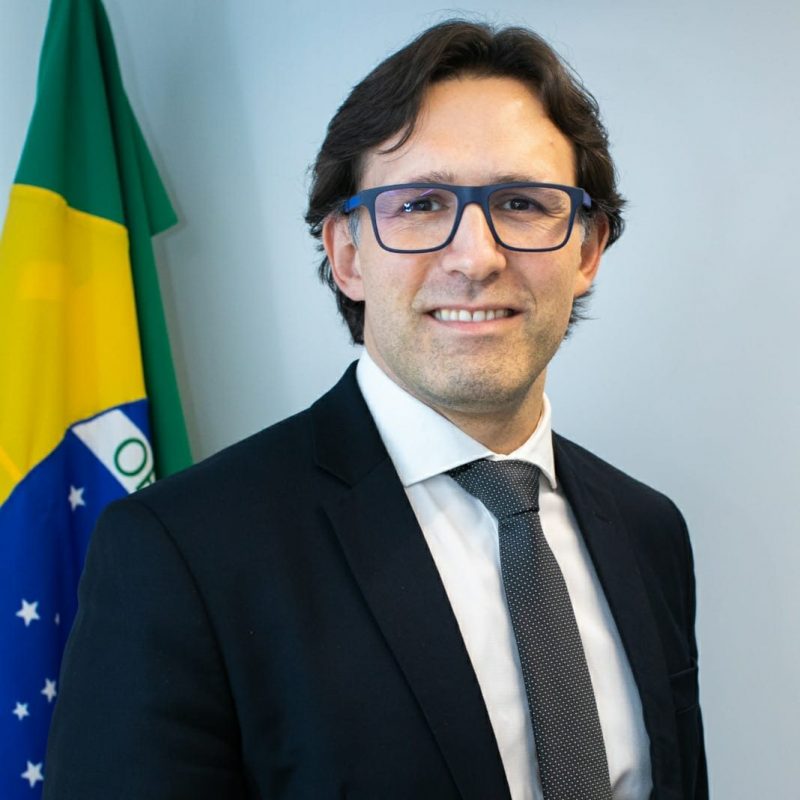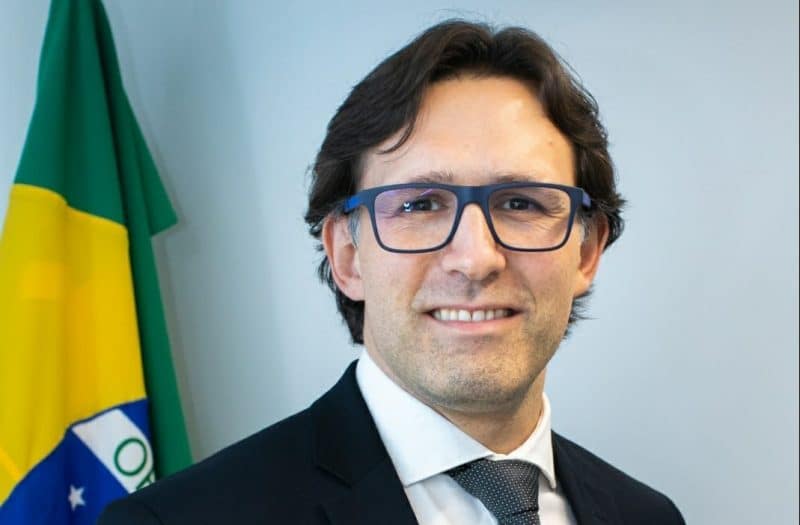Luis Felipe Monteiro is the Secretary of Digital Government in Brazil. He oversees digital transformation of the federal government and is dedicated to implementing innovative actions in the public sector focusing on the needs of Brazil’s 211 million citizens.

We discuss how to scale digital transformation in a large country, how digital approaches have enabled support of financially vulnerable people during the COVID-19 pandemic, digital identification, and where Brazil is focusing next.
“There is no efficient government without digital government. There is no digital government without interoperability. And there is no interoperability without privacy.”– Luis Felipe Monteiro
What does it mean to be the digital government secretary of Brazil?
As the digital government secretary of Brazil, Luis Felipe Monteiro’s main role is to coordinate and implement the digital transformation of public services and public policies within the federal government of Brazil.
Brazil is a federation split between the federal government, state and over 5,500 municipalities.
“Brazil has a population of over 211 million inhabitants – citizens that are right now receiving digital public services in a large scale,” Monteiro shared.
“I work together with more than 200 federal agencies to coordinate this effort. My team has around 7,500 public servants, two main IT-owned enterprises and many private-sector companies that are working with us to do this transformation,” Monteiro explains.
Monteiro’s challenges are to produce the right scale and to be exponential, to accelerate the digital transformation and to make the life of Brazilians better and easier.
Launching Gov.br – one of the top five government portals in usage in the world
In 2016 Brazil started the digital transformation of their government.
First, Brazil made a benchmark from many countries, including the U.K., Canada, Denmark, South Korea, and Uruguay.
“We had to establish common platforms, cross-agency platforms. We decided to define the main building blocks for digital transformation,” Monteiro said. One of the components was a portal to showcase the services and to establish simple and easy-to-use user experiences.
In 2019 with the beginning of the new government, Brazil had stakeholder engagement and ministries agreed that the government of the future would be a digital government.
“So, where to start? We decided to establish by the presidential decree one single channel to spread information on – institutional information, news about the policies, and also the provisioning of public services. Then, like gov.uk team did, we started to migrate the old infrastructure, the old website, we started to move everything to gov.br,” Monteiro explained.
“Right now, Gov.br is one of the top five governmental portals in usage in the world,” Monteiro shared, adding that it has only been around a year and a half, “so it’s quite new.”
Monteiro’s key advice for speeding up results is to “talk with international agencies, with universities, with companies like Microsoft that have international perspective and understand what the other countries are doing.”
A guide to quick transformation
From establishing the platform and commencing activity on the plan in 2019, there are now 100 million users of gov.br.
An incredible amount of progress was made in a short amount of time. Monteiro shares his insights on how rapid transformation occurred.
- High citizen demand – Brazil has a high number of internet users, which correlated to the likelihood for high adoption of the new technology.
- Establish consensus – Brazil received support from international research centers and international organizations, including the OECD, who made a peer review of the digital transformation in Brazil, which stated the highlights they should focus on to make the transformation.
- Utilize learnings from other countries – Learn from the journeys of other countries who have undergone digital transformation journeys and base the strategy on successful transformations, avoiding past mistakes.
- Cultural shift – Understand the precise cultural shift from the standard information technology way of working to the new digital transformation way of working where the citizen must be in the center of decisions.
Areas of emphasis for digital transformation
- Sell with persuasion– Create an internal team to “sell” the cultural shift and vision of digital transformation to get buy-in across all departments and levels of implementation.
- Agility – Continually test and make sure your products and platforms work for your citizens. Evolve continuously and be able to show results quickly.
Responding to the COVID-19 pandemic
The foundations Brazil put in place and the work of Monteiro’s team across the government helped prepare the country to respond quickly to some of the pressures of the COVID-19 pandemic.
“The capacity building and the networks we established since the beginning of the strategy gave us muscles to work with the pandemic and the digital inclusion of the society,” Monteiro said.
“We moved from 100% physical relationship to 100% digital in a few weeks. During the entire period, since the beginning of the pandemic to now, we transformed more than 1,000 public services that were previously only physical that are right now physical plus digital,” Monteiro continued.
The Brazilian government supported their citizens by getting emergency payments to a whole range of people quickly and easily.
“In only 30 days, we established the financial aid – the emergency aid that achieved 65 million Brazilians in peak,” Monteiro shared.
In one month, they established the legislation, platform, registers, payroll technology, communications, and everything to start receiving the requirements from citizens and to start working with them to make the payments.
“The entire government engaged in this movement, and we worked with the financial sectors – banks and the IT companies to create the emergency aid,” Monteiro explained.
As far as Monteiro knows, providing 65 million people with financial aid is the largest digital implementation of its kind in the world.
An overview of digital identity
“Digital identity is a platform that is structured within digital transformation. We started within the public service, so we have a product called gov.br ID, where it’s the digital identity from gov.br,” Monteiro explained.
There are currently around 4,000 public services connected to the digital identity, which includes all the services within the federal level in areas like health, education, revenue, and social security. Many states and municipalities are connected and integrating their services to the platform to ensure Brazil has a single-sign-on secure identity for every citizen.
Three levels of security for digital identity
There are three levels of security for digital identity:
- The first level is auto provisioning of the identity, with information provided by the citizen that the government can check within the database. This is one level of authenticity, where some services are provided.
- The second level, the silver level, is integrated among the financial sector (banking) databases. Gov.br ID is currently connected with seven major banks in Brazil. Brazilian citizens can use their banking credential to access more services.
- The third level, the gold level, is biometric verification. Brazil utilizes its biometric database for the electoral process.
In Brazil, voting is mandatory so every citizen over 18 years old must vote. To vote, the citizen must register, and the registration process includes biometric collection. From this registration process and collection, a biometric database is created.
“Using that biometrics database that is handled by the electoral court, we are providing a platform that checks biometric facial recognition and fingerprints to make sure the citizen can achieve the gold level of the digital identity,” Monteiro explained.
“In each of these levels, we have some sort of services that can be delivered based on the risk and the security needed for each services. Right now, we have 100 – 103 million Brazilians with digital identities in those three levels of security,” Monteiro shared.
Brazil is also working with the private sector and has hosted many workshops with private sector with the goal of reducing fraud and increasing digital adoption, among other benefits that a digital ID can deliver to a country.
Diving deeper into digital identification & privacy
Monteiro shared that the physical identification process can be handled by 40 different agencies in Brazil, so citizens can have 40 documents of identification. Within the digital ecosystem, Monteiro and his team wanted to remedy this to remove bureaucracy and have only one form of digital identification.
To achieve that, they had to establish a secure and precise way to identify citizens that needed to be scalable. They looked to a digital onboarding process and collaborated with the electoral court to utilize their biometric process. They made the digital ID privacy compliant.
“The data is owned by the citizen, not by the government. So, a citizen owns the data and he or she decides where to use it.”
The citizen can report any unusual activity and if any civil servants make an error or use the data inappropriately, there are penalties.
“There is no efficient government without digital government. There is no digital government without interoperability. And there is no interoperability without privacy,” Monteiro said.
Monteiro continued, “All of those requirements must be in place, and privacy first is something that is on our minds every day right now.”
Looking to the future – moving from a reactive to proactive approach
Brazil’s current government platforms are reactive, as in; a citizen must request something from government for the government to digitally provide that necessity.
“We want to use the platforms with the consensus of the citizen to be more proactive, to anticipate the needs of the citizen based on the data that they consent to share with us and all the usage of data, artificial intelligence, and mass personalization of our channels in a multichannel approach,” Monteiro explained.
Monteiro shared other countries are also working to create a proactive approach and because they are working towards the same goal simultaneously, they can share knowledge and learnings.
He also mentioned Brazil is talking with the private-sector marketplace.
“Here we have to be much more concerned on privacy because we handle sensible information. But with that privacy requirement on the table, we are talking with many marketplaces in many countries to understand how they do personalization within the digital ecosystem for the citizens,” Monteiro said.
Fonte: Microsoft
To find out more:
Follow Luis Felipe Monteiro on Twitter
Learn more about how Microsoft supports digital transformation in Government
GOVERNO E TECNOLOGIA
Aqui no Crypto ID você acompanha as principais ações do Governo Brasileiro e de outros Países relacionadas a privacidade, proteção de dados, serviços eletrônicos, formas de autenticação e identificação digital e Cibersegurança.
Acesse agora e conheça nossa coluna GovTech!






























